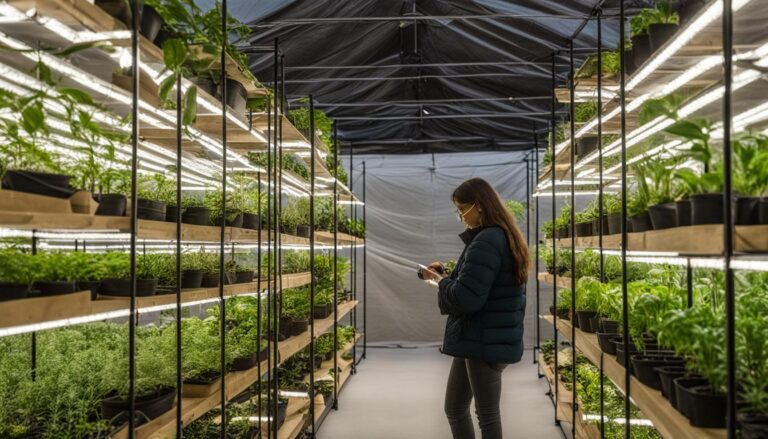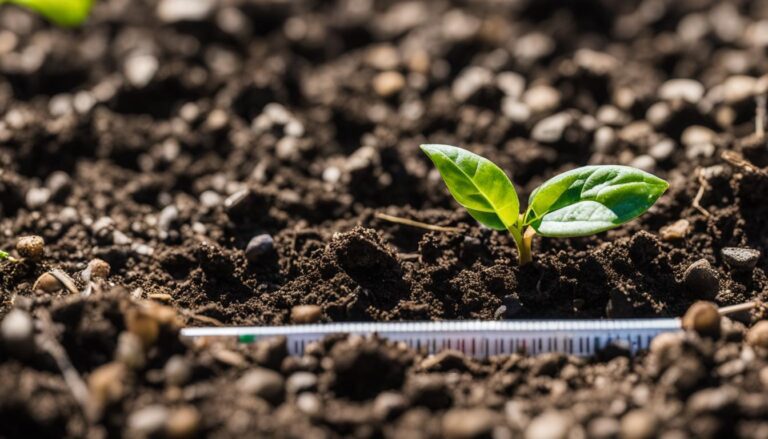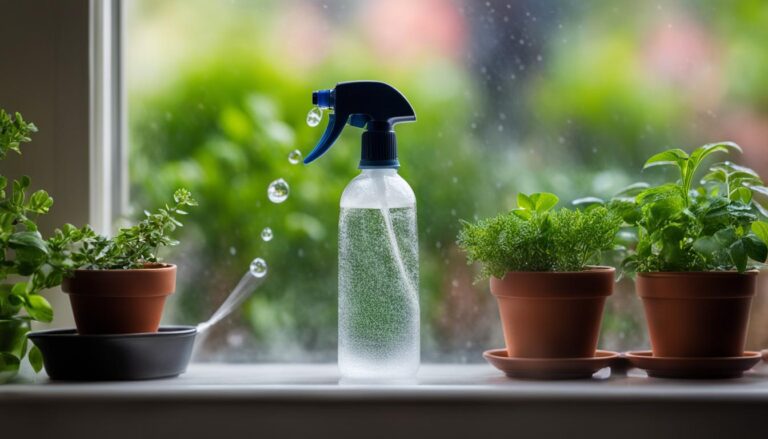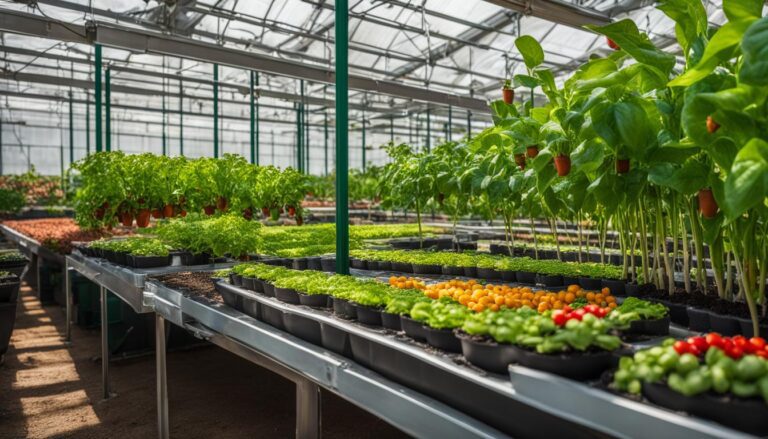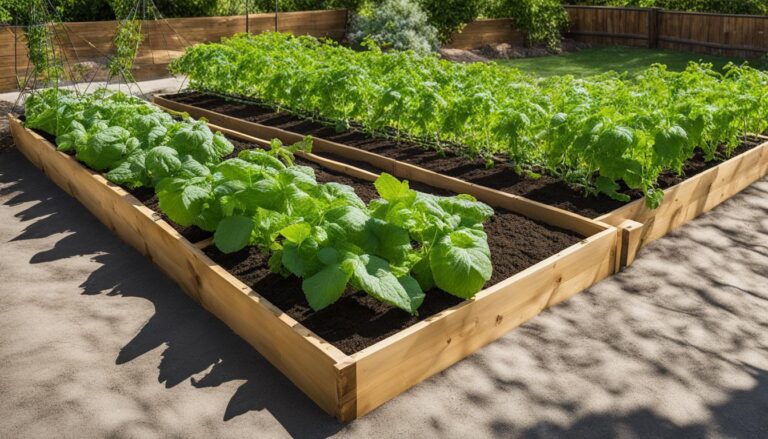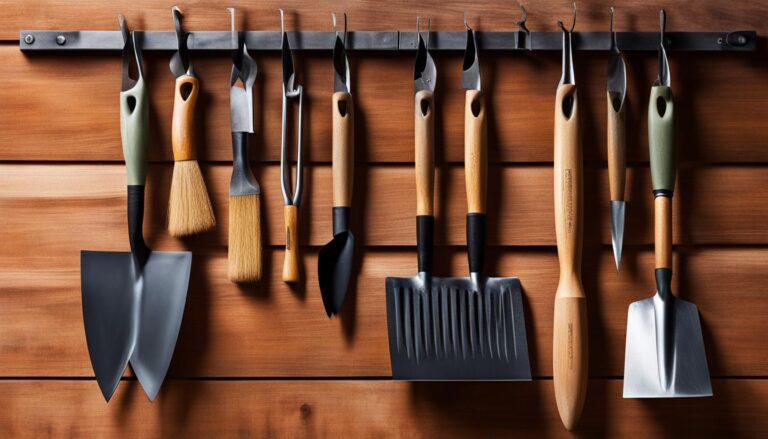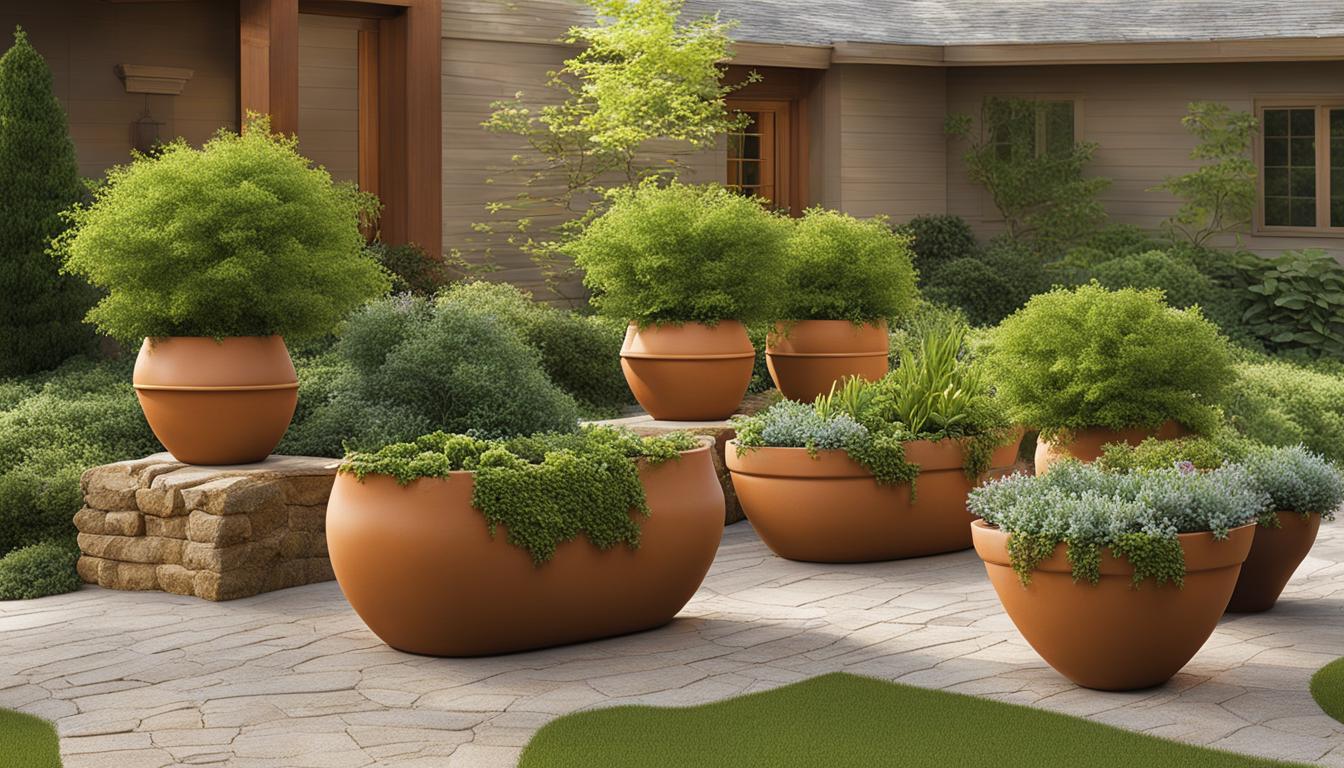
Commercial growers are increasingly turning to root-pruning planters to save costs and boost revenue. Traditional plastic nursery pots can lead to root circling, stunted growth, and transplant shock.
To address these issues, container root pruning offers three techniques: air root pruning, root entrapment, and root constriction. Each method has its own advantages and is suitable for different growing methods and circumstances.
Key Takeaways:
- Root-pruning containers are a cost-effective solution for commercial growers.
- Air root pruning promotes healthier and faster plant growth.
- Root entrapment and root constriction techniques stimulate lateral root growth.
- RediRoot air pruning pots offer a sustainable and effective solution for both commercial and home growers.
- Consider the specific needs of your plants and growing conditions when choosing root-pruning pots.
The Benefits of Air Root Pruning
Air root pruning is a technique that offers numerous advantages and promotes healthier root growth in plants. By using air root pruning pots, growers can foster a robust root system that enhances overall plant development and vitality. Let’s explore some of the key benefits of air root pruning:
Improved Root Development
Air root pruning stimulates the growth of lateral roots, resulting in a dense and fibrous root system. Unlike traditional pots, air pruning pots allow the roots to come into contact with air, which naturally causes the tips to prune themselves. This process encourages the development of numerous root branches, enabling efficient absorption of water and nutrients.
Reduced Transplant Shock
When plants are transplanted, their roots often experience shock, leading to stunted growth and diminished health. However, with air root pruning, transplant shock is significantly reduced. By eliminating root circling and preventing the formation of root-bound plants, air pruning pots ensure smooth and successful transplanting, promoting healthier and more vigorous growth.
Enhanced Nutrient Uptake
Proper nutrient uptake is crucial for plant growth and productivity. Air root pruning pots create an optimal environment for the roots to absorb nutrients efficiently. The dense network of lateral roots developed through air pruning allows for a greater surface area, increasing the plant’s ability to take in essential nutrients from the surrounding soil or growing media.
| Benefits of Air Root Pruning |
|---|
| Improved root development |
| Reduced transplant shock |
| Enhanced nutrient uptake |
In summary, air root pruning offers a range of benefits for plant growth and development. By utilizing air pruning pots, commercial growers and home gardeners alike can achieve healthier root systems, reduce transplant shock, and enhance nutrient absorption.
These advantages contribute to overall plant health and productivity, making air root pruning a preferred method for cultivating thriving plants.
Air Root Pruning Technique
Air root pruning is a highly effective technique used in horticulture to promote healthier root growth and prevent root circling. This technique relies on the exposure of roots to air, which dehydrates them and triggers self-pruning.
By using specially designed containers such as fabric air pruning pots or plastic air pruning pots, plants can develop a dense and fibrous root system, resulting in faster growth and improved nutrient uptake.
Fabric air pruning pots and plastic air pruning pots offer the necessary space for roots to grow through the pot walls and come in contact with the surrounding air. This exposure stimulates the roots to self-prune, preventing the formation of circling roots that can impede growth.
The self-pruning process encourages the development of lateral roots, which enhances the overall stability and nutrient absorption capabilities of the plant.
It is important to note that when using air root pruning pots, proper airflow around the containers must be ensured. This ensures that the roots receive adequate air exposure and prevents the accumulation of moisture, which can replicate the conditions of traditional smooth-walled plastic nursery pots.
By optimizing the air root pruning technique and providing the right environment for root growth, plants can thrive and reach their full potential.
Comparing Fabric Air Pruning Pots and Plastic Air Pruning Pots
| Aspect | Fabric Air Pruning Pots | Plastic Air Pruning Pots |
|---|---|---|
| Aeration | Excellent | Good |
| Root Self-Pruning | Effective | Effective |
| Moisture Retention | Low | Medium |
| Durability | High | High |
Both fabric air pruning pots and plastic air pruning pots have their advantages and are suitable for different applications. Fabric pots offer excellent aeration and superior root self-pruning, making them ideal for promoting extensive root development and preventing circling roots.
They also have low moisture retention, reducing the risk of overwatering. On the other hand, plastic pots provide good aeration and are more effective at retaining moisture, which can be beneficial in certain growing conditions.
Ultimately, the choice between fabric air pruning pots and plastic air pruning pots depends on factors such as the specific needs of the plants, the environmental conditions, and the grower’s preference.
Both options offer significant benefits over traditional nursery pots and contribute to healthier and more robust plant growth.
Root Entrapment Technique
The root entrapment technique is a popular method of promoting lateral root growth and preventing circling roots. It involves using fabric pots with a tight weave to trap the root tips before they penetrate the sidewalls. This stimulates the development of lateral roots, resulting in a well-branched and fibrous root system.
Root entrapment in fabric pots offers several benefits for plant growth. Firstly, these pots provide excellent aeration to the root zone, preventing root suffocation, and promoting healthy oxygen exchange.
Secondly, the fabric material allows for effective drainage, preventing waterlogging and reducing the risk of root rot. Lastly, fabric pots offer good nutrient retention, ensuring that plants have access to the essential elements they need for optimal growth.
Root Entrapment Benefits:
- Promotes lateral root growth and fibrous root system development
- Provides excellent aeration and prevents root suffocation
- Effective drainage to prevent waterlogging and root rot
- Good nutrient retention for optimal plant nutrition
Root entrapment in fabric pots is particularly beneficial for plants that prefer a well-drained growing medium and thrive with increased aeration. It is an effective technique for a wide range of crops, including vegetables, herbs, flowers, and small fruit trees.
Comparison of Root Pruning Techniques
| Technique | Advantages |
|---|---|
| Air Root Pruning | Stimulates root development, prevents transplant shock, improves nutrient uptake |
| Root Entrapment | Promotes lateral root growth, provides aeration, effective drainage, and nutrient retention |
| Root Constriction | Allows root expansion in controlled areas, ideal for stabilization and nutrient uptake |
In conclusion, the root entrapment technique using fabric pots is a valuable root pruning method that offers multiple benefits for plant growth.
It promotes the development of a well-branched root system, provides adequate aeration, drainage, and nutrient retention. Whether you are a commercial grower or a home gardener, considering root entrapment as part of your root pruning strategy can contribute to healthier and more vigorous plants.
Root Constriction Technique
In the world of root-pruning techniques, the root constriction technique offers a unique approach to promoting healthy root growth. This method involves using knit fabric pots with small hole openings to allow small roots to grow through but prevent them from expanding too much.
The benefits of this technique are numerous and can have a significant impact on the overall health and productivity of your plants.
One of the key advantages of the root constriction technique is its ability to create a well-branched, fibrous root system. By limiting the expansion of roots, the plant is encouraged to produce more lateral roots, resulting in a denser and stronger root structure.
This not only enhances the plant’s ability to absorb nutrients and water but also improves its overall stability and resilience.
Another benefit of using the root constriction technique is its compatibility with field soil. This technique allows small roots to grow into the soil, providing the plant with additional support and access to nutrients.
By combining the advantages of both the pot and the soil, the root constriction technique can optimize plant growth and development, particularly in outdoor or garden settings.
| Benefits of Root Constriction Technique | Explanation |
|---|---|
| Promotes well-branched, fibrous root system | Restricting root expansion encourages the production of lateral roots, resulting in a denser root structure. |
| Enhances nutrient and water absorption | A dense root system improves the plant’s ability to absorb essential nutrients and water efficiently. |
| Increases stability and resilience | A stronger root system enhances the plant’s stability and resilience to environmental stressors. |
| Compatible with field soil | Small roots can grow into the soil, providing additional support and access to nutrients. |
When implementing the root constriction technique, it is crucial to choose the right knit fabric pots with small hole openings. These pots ensure proper root constriction while allowing for sufficient airflow and drainage. It’s also essential to monitor the growth of your plants regularly and make adjustments to the constriction level as needed.
By harnessing the benefits of the root constriction technique, you can optimize the root growth of your plants and set them on a path towards healthier and more productive lives.
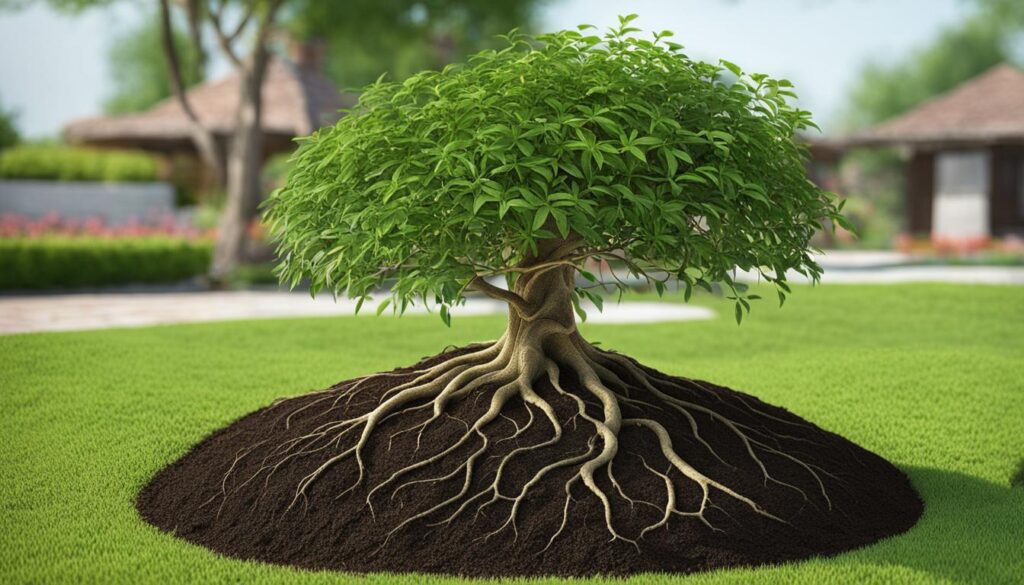
RediRoot Air Pruning Pots for Commercial Growers
When it comes to choosing the best planters for root-pruning, RediRoot air pruning pots stand out as a top choice for commercial growers.
These pots provide a conducive environment for root development, resulting in healthier plants and increased profits. The benefits of using RediRoot pots are numerous, making them a valuable investment for any commercial operation.
One of the key advantages of RediRoot air pruning pots is their ability to reduce transplant shock. By promoting air root pruning, these pots prevent root circling and encourage the growth of a dense, fibrous root system.
This leads to faster plant growth, improved nutrient uptake, and ultimately, higher yields. Commercial growers can enjoy the benefits of healthier plants and increased revenue by incorporating RediRoot pots into their cultivation practices.
Furthermore, RediRoot pots are designed with longevity in mind. Made from recycled materials, these pots are not only durable but also environmentally friendly.
By choosing RediRoot air pruning pots, commercial growers can reduce waste and minimize their ecological footprint, aligning their business practices with sustainable principles.
Benefits of RediRoot Pots for Commercial Growers
| Benefit | Description |
|---|---|
| Faster Growth | The air pruning technique stimulates root development, resulting in faster and healthier plant growth. |
| Increased Profits | By promoting a robust root system, RediRoot pots can lead to higher yields and improved crop quality, translating into increased profits for commercial growers. |
| Versatile Applications | RediRoot pots are suitable for a wide range of agricultural practices, including greenhouse cultivation, hydroponics, and container gardening. |
In conclusion, RediRoot air pruning pots offer significant benefits for commercial growers. With their contribution to improved plant health, increased profits, and environmental sustainability, these pots are a valuable asset in the horticultural industry.
Commercial growers can trust RediRoot to provide the necessary support for successful cultivation and maximize their yields.
RediRoot Air Pruning Pots for Home Growers
As the interest in home gardening continues to grow, RediRoot offers air pruning pots specifically designed for home gardeners. These pots provide the same benefits as the commercial-grade RediRoot pots, ensuring optimal plant growth and health for your garden.
Air pruning pots are an excellent choice for home growers as they promote healthier root development and reduce the risk of transplant shock.
The air pruning technique stimulates root growth and creates a dense, fibrous root system, leading to faster growth and increased nutrient uptake. With RediRoot air pruning pots, you can ensure that your plants thrive and flourish.
Using RediRoot pots in your home garden offers numerous benefits. Not only do they provide healthier and faster growth for your plants, but they also reduce maintenance costs and increase overall profits.
These pots are designed to be durable, made from recycled materials, and are environmentally friendly. By choosing RediRoot, you can enjoy the benefits of air pruning technology in your own backyard.
The Benefits of RediRoot Air Pruning Pots for Home Gardeners
1. Reduced transplant shock: Air pruning pots prevent root circling and promote natural root pruning, reducing the stress on your plants during transplanting.
2. Improved nutrient uptake: The dense, fibrous root system created by air pruning pots allows for better nutrient absorption, resulting in healthier and more productive plants.
3. Maximum plant growth: With air pruning pots, your plants can reach their full potential, growing faster and stronger than those in traditional containers.
| Container Size | Dimensions (inches) | Capacity (gallons) |
|---|---|---|
| 1 gallon | 6 x 6 x 7 | 1 |
| 3 gallon | 10 x 10 x 9 | 3 |
| 5 gallon | 11 x 11 x 11 | 5 |
Choose the right size of RediRoot air pruning pots based on the needs of your plants and the available space in your garden. Whether you’re growing vegetables, herbs, or flowers, RediRoot pots will provide the ideal environment for your plants to thrive.
Embrace the benefits of air pruning technology in your home garden with RediRoot pots. Experience healthier, faster-growing plants and enjoy the satisfaction of a bountiful harvest.
RediRoot Plastic Air Pruning Containers
RediRoot offers a wide range of plastic air pruning containers designed to meet the needs of commercial growers and home gardeners alike. These containers are made from recycled materials, ensuring both durability and sustainability. With various sizes available, RediRoot containers provide the perfect solution for different plant sizes and growing requirements.
RediRoot containers are available in capacities ranging from 1-gallon to 25-gallon, allowing growers to choose the size that best suits their specific needs. Each container is made from BPA-free plastic and is UV resistant, ensuring optimal protection for plants and longevity of the containers. The specifications for each container, including dimensions and volumes, are carefully designed to cater to different plant types and growing methods.
Table: Specifications of RediRoot Plastic Air Pruning Containers
| Container Size | Dimensions (L x W x H) | Volume |
|---|---|---|
| 1 Gallon | 6.5″ x 6.5″ x 7.5″ | 3.8 Liters |
| 5 Gallon | 10.5″ x 10.5″ x 10.5″ | 18.9 Liters |
| 10 Gallon | 14″ x 14″ x 12.5″ | 37.9 Liters |
| 25 Gallon | 20″ x 20″ x 16″ | 94.6 Liters |
RediRoot plastic air pruning containers provide the same benefits as their fabric counterparts. They promote air root pruning, preventing root circling and encouraging a dense, fibrous root system. These containers offer excellent aeration and drainage, ensuring optimal oxygen and moisture levels for root health. With RediRoot plastic air pruning containers, growers can enjoy the benefits of air pruning while utilizing the durability and convenience of plastic containers.
RediRoot Testimonials
RediRoot has received glowing testimonials from numerous satisfied customers, ranging from commercial growers to landscapers. These testimonials highlight the exceptional benefits and success stories associated with using RediRoot pots for root pruning and plant growth. Here are some customer reviews that showcase the effectiveness of RediRoot pots:
Increased Profits and Healthier Plants
John, a commercial tomato grower, shares his experience with RediRoot pots: “Since switching to RediRoot pots, my tomato plants have exhibited healthier growth and a denser root system. The air pruning technique has significantly reduced transplant shock, resulting in higher survival rates and increased profits for my business.”
Improved Plant Development and Maintenance Cost Savings
Sarah, a landscaper, states, “I have been using RediRoot pots for my landscaping projects, and I am incredibly impressed with the results. The air pruning technology has promoted robust root growth, leading to better overall plant development. Also, the reduced need for root pruning during transplanting has saved me valuable time and maintenance costs.”
Success with a Variety of Crops
Michael, a vegetable farmer, shares his success story: “I have used RediRoot pots for a range of crops, including peppers, cucumbers, and lettuce. The root pruning technique has consistently produced healthier plants with stronger root systems, resulting in improved nutrient uptake and higher yields. RediRoot pots have become an essential part of my farming practices.”
These testimonials demonstrate the effectiveness of RediRoot pots in promoting healthier root growth, reducing transplant shock, and maximizing plant growth and profitability. Customers have reported positive experiences and significant benefits across various crops and applications. RediRoot’s commitment to quality and sustainability has made it a trusted choice for both commercial growers and home gardeners alike.
RediRoot and the Environment
As an environmentally conscious company, RediRoot understands the importance of minimizing its environmental impact.
We take steps to ensure that our products are sustainable and contribute to eco-friendly gardening solutions.
One of the ways we address sustainability is by using injection molds during our manufacturing process. This method reduces the amount of plastic used, helping to conserve resources and minimize waste. By utilizing recycled materials, our pots are made from a minimum of 80% recycled content, further reducing our reliance on virgin materials and supporting a circular economy.
RediRoot pots are designed for long-term use, promoting reuse and reducing the need for frequent replacements. This not only saves growers money but also helps to reduce plastic waste. Additionally, our pots can be recycled at select recycling centers, ensuring they can be properly disposed of at the end of their lifespan.
Environmental Benefits of RediRoot Pots
By choosing RediRoot pots, growers can enjoy several environmental benefits. Firstly, our pots promote healthier root growth, leading to more resilient plants that require fewer pesticides and fertilizers. This reduction in chemical usage helps to minimize the impact on local ecosystems and reduces water pollution.
Furthermore, RediRoot pots encourage the development of dense, fibrous root systems. These root systems contribute to soil stability and erosion prevention, making them ideal for landscaping and restoration projects. The enhanced nutrient uptake provided by our pots also ensures that plants can thrive with less fertilization, reducing the amount of synthetic nutrients released into the environment.
Overall, RediRoot is committed to providing sustainable and eco-friendly gardening solutions. By choosing our air pruning pots, growers can not only achieve optimal plant growth but also contribute to a greener future.
| Environmental Benefits of RediRoot Pots | How RediRoot Pots Contribute |
|---|---|
| Promote healthier root growth | Reduces the need for pesticides and fertilizers, minimizing chemical impact on ecosystems and waterways. |
| Create dense, fibrous root systems | Improve soil stability and prevent erosion, making them ideal for landscaping and restoration projects. |
| Enhance nutrient uptake | Reduces the need for excessive fertilization, minimizing the release of synthetic nutrients into the environment. |
After exploring the various root-pruning techniques and the benefits they offer, it is clear that choosing the right planters for root-pruning is crucial for promoting healthier root growth and maximizing plant development.
Air root pruning, root entrapment, and root constriction are all effective methods for preventing root circling and stimulating the growth of dense, fibrous root systems. However, the specific technique you choose will depend on factors such as your growing method, plant type, and specific requirements.
For commercial growers, RediRoot air pruning pots have emerged as a popular and reliable choice. These pots provide a conducive environment for root development, reducing transplant shock and promoting rapid nutrient uptake.
The testimonials from satisfied customers, including commercial growers and landscapers, attest to the effectiveness and durability of RediRoot pots.
Even home gardeners can benefit from using RediRoot pots to achieve optimal plant growth in their gardens. The same benefits that make them popular among commercial growers, such as reduced transplant shock and improved nutrient uptake, can be experienced by home gardeners as well. RediRoot aims to make gardening accessible and enjoyable for everyone.
FAQ
What are the best planters for root-pruning?
The best planters for root-pruning are air root pruning pots, specifically fabric air pruning pots and plastic air pruning pots.
What are the benefits of air root pruning?
Air root pruning stimulates root development, reduces transplant shock, improves nutrient uptake, and creates a dense, fibrous root system.
How does air root pruning work?
Air root pruning relies on the exposure of roots to air, which dehydrates them and causes self-pruning. Fabric and plastic air pruning pots provide the necessary space for roots to grow through the pot and self-prune.
What is the root entrapment technique?
The root entrapment technique involves using fabric pots with a tight weave to trap root tips, stimulating lateral root growth and preventing roots from growing through and circling.
What is the root constriction technique?
The root constriction technique allows small roots to grow through a knit fabric base but prevents them from expanding too much. This technique is often used in conjunction with field soil for stabilization or nutrient uptake.
What are RediRoot air pruning pots?
RediRoot air pruning pots are high-quality containers designed for root pruning. They provide a conducive environment for root development, reducing transplant shock and promoting rapid nutrient uptake.
Can home gardeners benefit from RediRoot pots?
Yes, RediRoot offers air pruning pots specifically designed for home gardeners. These pots provide the same benefits as the commercial-grade RediRoot pots and promote optimal plant growth in home gardens.
What sizes do RediRoot plastic air pruning containers come in?
RediRoot offers a range of plastic air pruning containers in different sizes, from 1-gallon to 25-gallon capacities. These containers cater to different plant sizes and growing needs.
Are RediRoot pots made from recycled materials?
Yes, RediRoot pots are made from a minimum of 80% recycled materials and are designed for long-term use, reducing waste and environmental impact.
What do customers say about RediRoot pots?
Customers have reported reduced maintenance costs, healthier plants, and increased profits when using RediRoot pots. They have praised the durability and effectiveness of these pots for various crops.
How is RediRoot minimizing its environmental impact?
RediRoot uses injection molds to reduce the amount of plastic used during manufacturing. The pots are designed for reuse and can be recycled through select recycling centers.
How should I choose the best planters for root-pruning?
The choice of planters depends on factors such as growing method, plant type, and specific requirements. Consider the different root-pruning techniques and select the most suitable pots for your plants’ needs.

